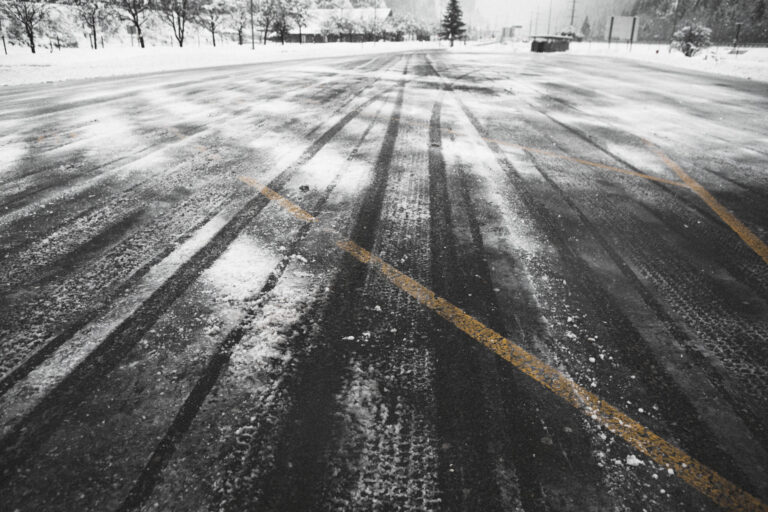Black Ice Timing: Peak Occurrence Times

Winter is not just about the snowy landscapes and the cozy evenings by the fire. For drivers and pedestrians, it’s also a season of vigilance, especially when it comes to black ice. One of the most treacherous aspects of black ice is its unpredictability. However, there are certain times of the day when the occurrence of black ice is most frequent. Understanding the “what time of day does black ice occur” is the first step in ensuring one’s safety during winter months.
The Mystery Of Black Ice: What Time Of Day Does Black Ice Occur
Before delving into the timings, it’s crucial to understand the nature of black ice. This thin layer of ice is transparent and often looks like a wet spot on the road or pavement. Its name derives from its ability to camouflage with the asphalt, making it virtually invisible to unsuspecting drivers and pedestrians.
Predawn And Late Evening: The Peak Black Ice Hours
While black ice can form at any time, certain conditions make its appearance more likely. The answer to “what time of day does black ice occur” lies in the temperature fluctuations that typically occur around dawn and dusk.
- Early Mornings: During the nighttime, the temperature often drops. Without the sun’s warmth, and with the cold air, moisture on the roads can quickly freeze, especially just before dawn when temperatures are at their lowest.
- Late Evenings: As the sun sets and temperatures begin to plummet, any moisture, whether from melting snow, rain, or even dew, can solidify into black ice patches.
Factors Amplifying Black Ice Formation
While dawn and dusk are peak times, other factors can exacerbate black ice formation:
- Cloudless Nights: Clouds act like Earth’s blanket. A cloudless sky means more heat escapes, leading to cooler ground temperatures and ideal conditions for black ice.
- Geographical Factors: Bridges and overpasses are more susceptible. They’re exposed to cold air from both top and bottom, causing them to freeze before traditional roads.
- Snow Melt: During the day, snow can melt, creating wet patches. As temperatures drop in the evening, these patches can swiftly turn into black ice.
Get ready for winter with Walk On Ice instant traction on snow and ice
Confronting Black Ice: Steps To Safety
Accidentally encountering black ice is a scary experience. However, knowing “what to do on black ice” can make a significant difference:
- Stay Calm: Panic can lead to overcorrection. If you feel your vehicle skidding, remain calm and avoid making sudden movements.
- Steer Gently: If your car starts to slide, gently steer in the direction you want the front of your car to go.
- Avoid Sudden Braking: Slamming the brakes can worsen the skid. Instead, let off the gas and allow the car to slow down naturally.
- Increase Following Distance: In icy conditions, maintain a more significant gap than usual between your car and the vehicle in front.
- Avoid Cruise Control: Manual Control Of Your Vehicle’s Speed Allows For Quicker Reactions If Black Ice Is Encountered.
The ‘Walk On Ice’ Assurance
For those moments when you’re outside your car, or even just stepping outside your home, the threat of black ice remains. ‘Walk On Ice’ is the reliable partner in these situations:
- Safety First: Crafted from all-natural minerals, ‘Walk On Ice’ provides an unparalleled traction solution, reducing the risk of slips and falls on icy patches.
- Environmentally Friendly: With no harmful salts or chemicals, it’s a solution that respects the environment while ensuring your safety.
- Versatility: Whether it’s your driveway, the parking lot at work, or anywhere in between, ‘Walk On Ice’ is your go-to for preventing unforeseen slips.
Where Is Black Ice Often Found in Daily Life?
Understanding when black ice appears is one step, but just as important is knowing where is black ice often found. Certain places become hotspots every winter. Bridges and overpasses freeze first because they’re exposed to cold air above and below. Residential driveways and sidewalks near gutters are another danger zone, since melting snow drips down during the day and hardens overnight.
Parking lots can also be deceiving. Meltwater from plowed piles tends to spread across flat pavement and refreeze into sheets. Even intersections can harbor thin layers of black ice where car tires pack snow, melt it slightly, and then leave behind a slick glaze once the temperature drops again. The takeaway? Black ice rarely covers an entire road or sidewalk — it hides in patches, waiting where you least expect it.
Black Ice Temperature: The Sweet Spot for Danger
So, what is the black ice temperature to watch out for? Black ice usually forms when air temperatures hover right around freezing — 32°F (0°C). But here’s the trick: the road surface itself may be colder than the air. That’s why black ice can appear even when your dashboard thermometer reads a few degrees above freezing.
Nighttime and early morning lows in the 20s are especially risky. Add in clear skies, which let ground heat escape, and you have the perfect setup for invisible ice. Drivers and pedestrians often let their guard down when temperatures rise slightly during the day, but black ice can cling to shaded spots or wind-exposed surfaces long after the sun comes up.
How to Drive on Black Ice Without Losing Control
Once you know where and when to expect it, the next question becomes: how to drive on black ice safely? The rule of thumb is to stay as calm as possible. Jerky movements — slamming the brakes, cranking the steering wheel, or flooring the gas — are what turn a slip into a spin. Instead, ease off the accelerator and let the car slow down on its own. Keep your steering gentle and steady.
If you’re driving in conditions where black ice is likely, reduce your speed and increase your following distance. This gives you extra time to react. Avoid cruise control because you need full control over your acceleration. And above all, remind yourself that black ice is unpredictable — driving slower than usual is the single best safety measure.
What to Do When You Hit Black Ice Suddenly
Even with caution, sometimes you’ll still encounter it. So, what to do when you hit black ice and feel your vehicle slipping? The first step is to resist panic. Take your foot off the gas and keep your steering wheel pointed in the direction you want to go. If the back of your car begins to fishtail, gently steer into the skid rather than fighting it.
Avoid slamming on the brakes — this often makes the skid worse. If you need to slow down, apply brakes lightly and steadily, especially if you have anti-lock brakes. Remember that overcorrection is your enemy; small, controlled movements are what will help you regain control. And once you’ve passed the patch, continue driving cautiously — black ice rarely appears in just one spot.
Conclusion
Recognizing when black ice occurs is only part of staying safe in winter. Knowing where black ice is often found, what black ice temperature makes it most likely, how to drive on black ice, and what to do when you hit black ice completes the picture. It’s this layered awareness that helps you anticipate danger rather than react too late.
And when you’re on foot, the same principle applies. Sand and kitty litter may scatter or clump, but Walk On Ice delivers traction instantly, keeping your steps steady whether you’re crossing a driveway, heading into work, or walking the dog. Its natural, chloride-free formula means you don’t sacrifice safety for convenience — you get both.
Black ice may be invisible, but it doesn’t have to catch you off guard. With preparation, patience, and the right tools, winter becomes less about fear and more about confidence — no matter how slick the conditions get.
Other Ice Melt Products
Safe Paw
The Original and #1 Selling Pet and Child Safe Ice Melt for over 20 years. Guaranteed environmentally safe – will not harm waterways and sensitive wetlands. All products are made in the USA.

Safe Thaw
Imagine an ice melt you can put down and never worry about. It won’t harm pets, kids, and your property. That’s Safe Thaw. Unlike anything else on the market, Safe Thaw can change how winter affects our planet.



